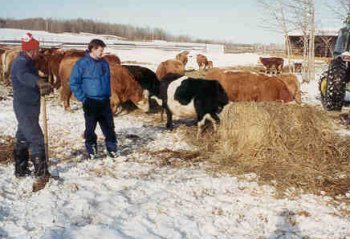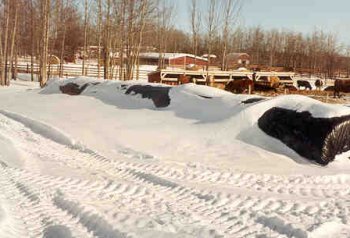| Why bale silage? | Fermentation | How soon should bales be wrapped or tubed? | How much plastic? | How long can baled silage or haylage be stored? | Are forage preservatives necessary?
Bale silage involves the preservation of perennial or annual forage crops. Either round or mid-sized square baling systems can be used to produce bale silage.
The key is that the baler needs to produce a dense bale. Soft-core bales are not as effective for making bale silage. Because the forage crop is baled, the silage is maintained as a long fibre forage source.
Why bale silage?
The use of bale silage offers livestock producers an option to improve feed quality and reduce field losses (Figure 1). Silage systems can increase dry matter production by up to 30 per cent when compared to traditional dry hay systems. The key is to keep this advantage through to feeding by minimizing other types of losses.

Figure 1. The acid test-cows doing well when fed bale silage.
Plan out the process and bale at the right moisture content. Good quality forages should be selected for bale silage. Over-mature forage crops should be not be used in bale silage systems.
Bale silage also has the added advantage of allowing producers to use normal bale handling and feeding equipment. Because silage bales are heavier, they need to be made smaller than conventional hay bales. Also, producers need to make sure the dimensions of the silage bale match the commercial tubing or wrapping systems being used.
Fermentation
Quality silage is achieved when lactic acid is produced during the ensiling process. Lactic acid is the most efficient fermentation acid and will drop the pH of a forage crop faster than any other. The faster the fermentation process is completed, the more stable the silage will be. In addition, fast fermentation means more nutrients are retained within the silage.
In chopped silage, the fermentation process will normally produce silage with a final pH range of 4.0 to 4.5. In bale silage, producers can expect to see a final pH in the 4.7 to 5.8 range. The higher pH values associated with bale silage are due in part to a slower fermentation process. Maintaining the crop as a long fiber product results in a slower release of plant nutrients that support the growth of acid-producing bacteria. As a result, there is generally less fermentation in bale silage than in chopped silage.
Forage moisture can also influence the level of fermentation. Ensiling bales at 45 to 55 per cent moisture provides adequate moisture for fermentation. Forages baled at lower moisture levels may have minimal fermentation, resulting in higher pH values. Although fermentation may not occur in drier forage, field experience has shown that these bales will often keep as "wet hay" when wrapped or tubed.
A partial answer for this situation involves the use of high density balers and the quick tubing or wrapping of the bales. The compaction provided by high density balers limits the amount of oxygen in the bale. This condition creates a anaerobic state (oxygen limiting), which can limit mold growth. Also, sealing the bales with plastic within a few hours of baling will prevent secondary air movement into the bales.
The use of both high density square or round balers and rapid sealing may provide forage producers with a management option when hay is baled in the 35 to 45 per cent moisture range. Remember, if the objective is to produce bale silage, then the moisture content at the time of baling should be in the 45 to 55 per cent range. It is generally advisable to start baling at the higher moisture content since the material dries as the day progresses.
Ideally, silage bales should not be fed until the silaging process is virtually complete. This takes from 12 to 20 days if the bales are wrapped within five hours of baling. The process could take longer if the bales are not wrapped within that five hour window.
How soon should bales be wrapped or tubed?
Wrapping or tubing should occur as soon as possible, ideally within five hours of baling. Delaying the operation beyond 10 hours may result in a slower fermentation process and, therefore, a slower drop in silage pH.
How much plastic?
A suggested minimum for plastic wrapping or tubing is 4 ml, as either plastic wrap or tube. If the feed is to be carried over from one feeding season to the next, it is advisable to consider higher ml ratings, up to 8 ml.
How long can baled silage or haylage be stored?
Bale silage can be stored from one season to the next (Figure 2). The key is to prevent air movement into the sealed bales. Exposure to air will lead to spoilage of the ensiled forage. Bales should be fed out when the plastic cover has been opened or damaged.

Figure 2. Winter storage of round bales.
Bales put up at less than 45 per cent moisture or in a more mature state should be fed out during the first winter feeding period. This type of forage lacks the stability of ensiled forages and should not be carried over from one feeding season to the next.
Are forage preservatives necessary?
Forage crops baled in the 45 to 55 per cent moisture range should store adequately without the need for forage preservatives. Some research has indicated that the application of silage inoculants can help in the production of lactic acid, which can lead to lower pH values than untreated bale silage. Producers should check with product suppliers to ensure that products have been tested for use on bale silage systems.
If silage additives are considered, the most common products in the marketplace are either mold inhibitors (acid based) or fermentation stimulants (microbial inoculants). If these products are used, it is important to ensure that application equipment is adjusted so that sufficient product is applied to the forage crop. Factors such as forage moisture content and baling rate (tonnes/hour) should be considered when calibrating application equipment.
Prepared by:
Allan Macaulay, PAg
Provincial Silage System Specialist
Alberta Agriculture, Food and Rural Development
Source: Agdex 100/52-1 January 2003. |